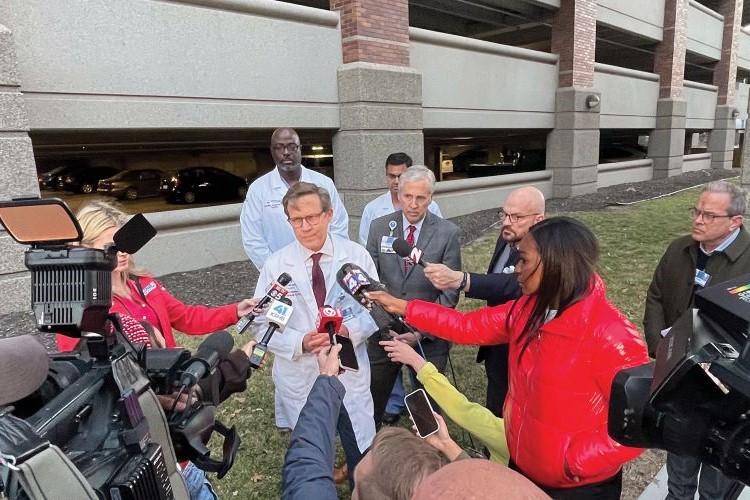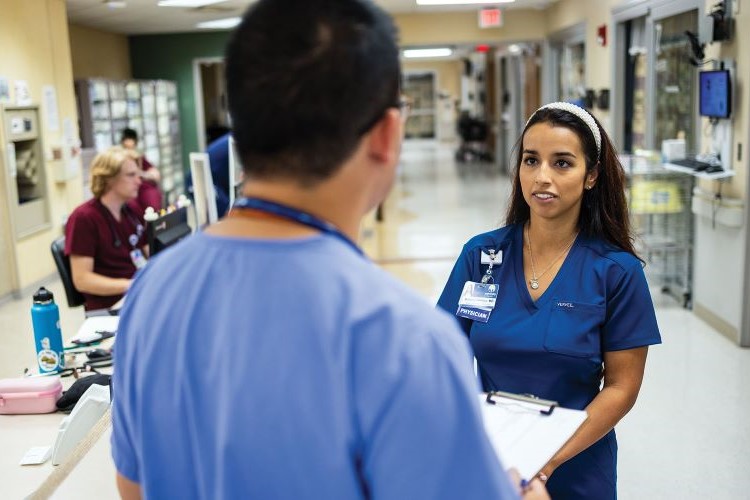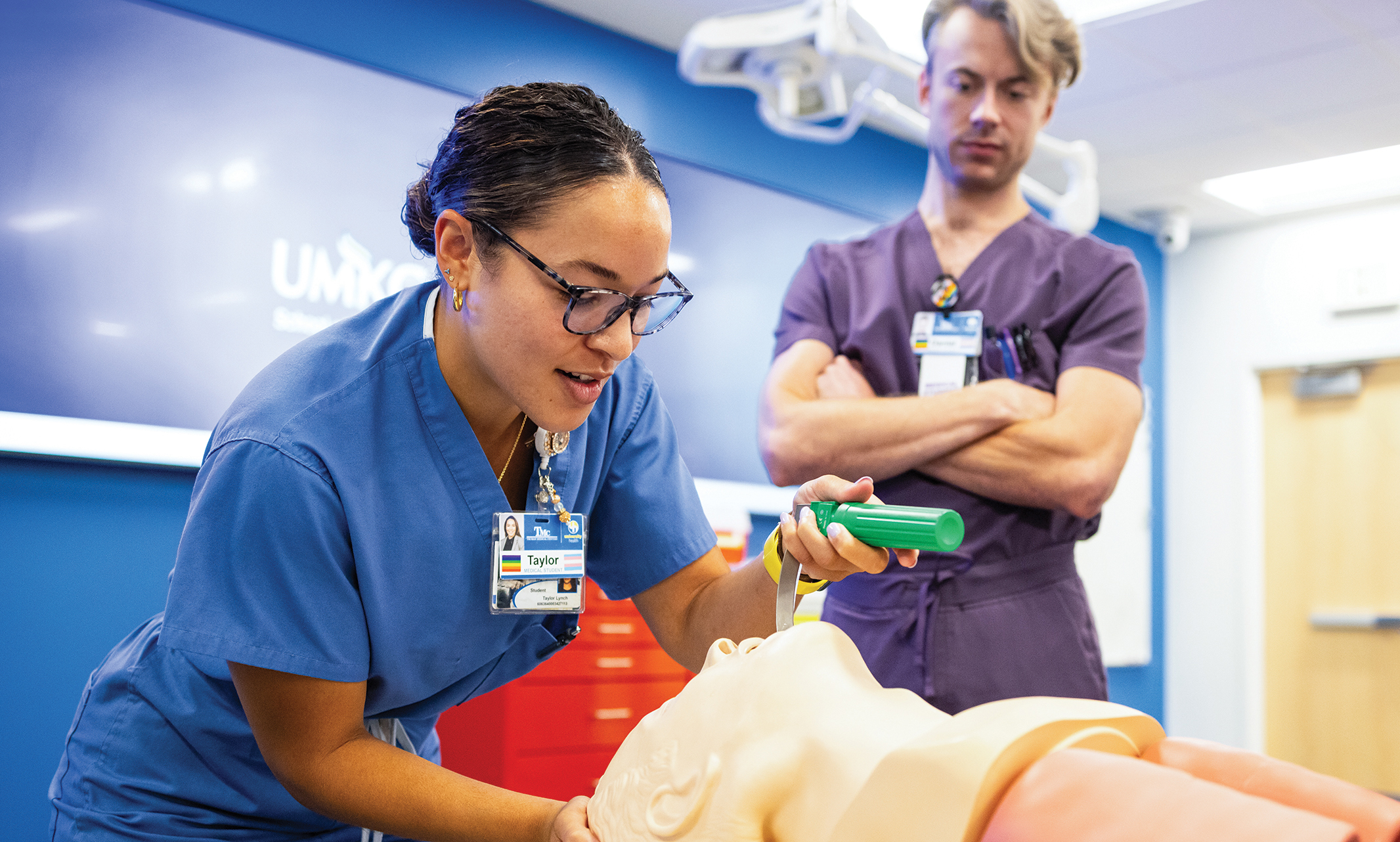It was an unseasonably warm February morning. Fans in Kansas City Chiefs red congregated around Union Station, the post-victory parade rally spot for celebrating the world-champion team. As the rally ended, thousands crowded around, hoping to get one last glimpse of their favorite football players.
As confetti fell, loud pops rang in the air. Shouts and screams erupted. Police officers rushed parade goers away from the scene. A tragedy unfolded on live television, and the community soon learned several people – including children – had been shot, and one person killed.
Immediately, emergency responders rushed into the chaos. University Health and Children’s Mercy Kansas City staff – including UMKC emergency medicine faculty, residents and fellows – provided medical care both on site and back at the hospitals to those who were injured.
Despite the fear, sadness and confusion that day, the residents responding were all able to work swiftly, efficiently and calmly, thanks in large part to the education they receive at UMKC. The rigorous emergency medicine residency training – along with the emergency response preparation all its medical students receive – are critical pillars of the curriculum at the School of Medicine.
Preparation is Key
Mark Steele (B.A./M.D. ’80), associate dean and chief clinical officer at University Health, said while mass casualty situations are never expected, emergency medicine physicians are always prepared for them.
“There are different policies and procedures written and reviewed on a regular basis,” Steele said. “There are community-wide disaster drills we take part in. It’s the repetition of the mechanics that gets us prepared.”

To reach that level of preparation, doctors must train and practice for years – and all UMKC School of Medicine students have some degree of emergency training, no matter what specialty they pursue. Every student must complete an emergency medicine clerkship in their fifth or sixth year, which Steele said isn’t common at most other medical schools.
Melanie Camejo (BLA ’13/M.D. ’14) is the school’s emergency medicine clerkship director. She is also an associate professor, associate fellowship director and associate emergency residency director at the school, as well as an emergency medicine physician at University Health.
“We do disaster drills and simulations in the trauma bay at a moment’s notice, have weekly didactics (or workshops) that cover emergency topics and have monthly simulation didactics,” Camejo explained.
During these simulations, students and residents are assigned roles they might have in a real-life hospital setting. An ED attending follows along with a script and controls a manikin “patient,” which mimics a human’s real reactions. The “patient” can either stay alive or code – depending on which actions the students decide to take in the moment. This makes the scenario as real as possible – without an actual life at stake. Once the simulation is complete, the group debriefs and everyone has an opportunity to give feedback.
“We offer a seizure simulation, heart failure simulation and a ‘sick or not sick’ simulation for our students,” Camejo said. “The manikins are neat because they make noise, have pulses and can tell if it’s been correctly intubated. These simulations are great for students because they all get to oversee different aspects and work together to keep the simulated patient alive like they would in the emergency room.”

The Heart of Kansas City
Unlike other peer institutions, UMKC has affiliations with seven hospitals that allow UMKC medical students and residents to train more effectively. The affiliate hospitals provide students with multiple specialties to choose from, specialized equipment to work with and a large variety of patients and cases to see. This is beneficial for all students and residents, but especially for residents in the emergency medicine program.
Emily Hillman (BLA ’07/M.D. ’08), the school’s emergency medicine residency program director, said one of the university’s best attributes is its location within the city.
According to Camejo, because of the large influx of patients at hospitals like University Health, UMKC students and residents who train there also get more of an opportunity to practice being quick on their feet.
“You don’t have time to prepare for a stressful situation in the emergency department,” Camejo said. “They happen in seconds with no warning, so every shift you go in knowing that anything can happen. Most of us do our best thinking in high-stress situations.”
Dustin Neel, M.D., associate professor at the UMKC School of Medicine and trauma medical director at University Health, believes practicing inside an emergency room in downtown Kansas City prepares students for anything once they graduate.
“It is already uncommon to have a trauma department, but University Health is a Level 1 trauma center,” Neel said. “That, plus our location and population, allows for a great variety of pathologies of various diseases people just don’t see very often, which allows the medical students to get comfortable seeing things they might only see once in their career.”
Jennifer Watts, M.D., MPH, is a professor at UMKC and pediatric emergency medicine physician at Children’s Mercy. Instead of a lecture hall, Watts does most of her teaching in the hospital – the only place medical students in Kansas City can train in pediatrics.
“There are a lot of benefits to being the only training program for pediatrics in our city – and really in our region,” Watts said. “We know when UMKC students, residents and fellows leave us, they have a solid foundation in pediatrics that allows them to take care of kids and to provide high-quality pediatric care – no matter where they are.”
Six-Year Program Sets Students Apart
The unrivaled emergency medicine curriculum at UMKC isn’t something that developed overnight. Adam Algren (B.A./M.D. ’01), chair of UMKC’s emergency medicine program, said UMKC’s program was one of the first of its kind in the country, and added that the program’s longevity is one reason acceptance letters are so sought after.
“We have a lot of history and tradition,” Algren said. “We’ve trained more than 400 emergency physicians who have gone out and practiced throughout the country, and we have quite a few alumni who have served in various leadership roles.”
The unique six-year B.A./M.D. program at UMKC also allows students to get more hands-on experience than at a typical four-year medical school. That extra experience makes a big difference in the emergency room – and mentors notice.
“I work with residents from many different programs,” Watts said. “The UMKC graduates have all been extremely well prepared to handle any emergency. They come with such a great foundation that it makes our job easier.”
Scott McCulloch (B.A./M.D. ’89) is a retired emergency medicine doctor who completed his residency with UMKC at University Health. He felt much more prepared than his fellow residents because the program at UMKC provided him with experiences they didn’t have.
“I think having interaction with patients since the age of 18 is something that can’t be compared or exchanged,” McCulloch said. “I remember when I started my residency, there were residents from other programs, and they were always so surprised with how seasoned and comfortable we were around patients. We were already ahead of the game.”
Meaningful Mentorships
The UMKC emergency program also has deeply committed faculty and staff. Alexander Garza, M.D. (B.S. ’90) received his undergraduate degree at UMKC and came back to complete an emergency medicine residency. In 2009, appointed by President Barack Obama, Garza served as assistant secretary for health affairs and as chief medical officer for the U.S. Department of Homeland Security. Today, he is chief community health officer at SSM Health in St. Louis.
Garza said what he remembers most about his time at UMKC is the dedication of the faculty.
“I think what set UMKC apart were the staff and instructors that I had,” Garza said. “They were truly vested in the mission, from the way they took care of patients in the emergency department to the care they delivered.”
McCulloch shared a touching story about one of his mentors.
“I’ll never forget our exit interview when we were finishing residency,” McCulloch said, with tears in his eyes. “At the time, Mark Steele was our residency director. He told me from that point forward, I am always going to be considered a peer and not just a mentee. I always get choked up because it means so much to me, even all these years later.”

